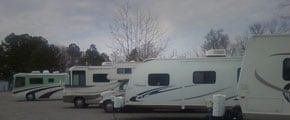In many locations, local laws or homeowner’s association regulations keep people from parking RVs outside their homes or in driveways for more than a defined length of time. Putting your RV in self storage can help you avoid fines or towing fees. RV storage is also a worry free way to keep your camper safe and in good condition when you’re not on a road trip. Here are some tips to help you store your recreational vehicle long-term.
Understand Your RV Storage Options

Covered RV Parking Spaces
If you’re not sure whether you should choose lot or indoor storage, covered RV storage is a good option. It provides some protection at a lower cost than indoor storage. Owners of particularly large RVs often use a covered parking space when indoor storage isn’t an option.

Outdoor RV Parking Spaces
Outdoor parking spaces are less costly, but they can leave recreational vehicles exposed to hazards like severe storms. If you pick this option, it’s a good idea to get a full-sized RV cover to protect your motorhome.

Indoor RV Storage Units
Indoor drive-up units may be more expensive, but they provide more protection from the elements, theft, and vandalism. Some insurance companies also provide a discount when a vehicle is stored indoors in a garage or another facility. With a climate-controlled storage unit, you can protect your RV from extreme temperatures.
Cost of Long-Term RV Storage
Amenities for RV storage tend to increase the price. The average cost for storing an RV or camper is $134.35 per month. However, self storage prices can vary widely depending on your location and the size of your RV.
How to Prepare Your RV for Long-Term Storage
Take these steps to prepare your motorhome for long-term storage and help prevent damage.
- Clean the interior and exterior surfaces with a particular emphasis on getting rid of moisture. This will help prevent mildew and rusting.
- Check mechanical functions to make sure that everything is in working order.
- Top off or replace fluids like oil, coolant and antifreeze.
- Fill up the gas tank and add fuel stabilizer. This helps prevent moisture buildup and keeps the gas from breaking down.
- Drain the water system and get rid of anything perishable that could spoil in storage.
- Cover your RV for extra protection. Here’s a list of RV cover reviews and recommendations.
- Take off the tires or put on wheel chocks. This keeps flat spots from developing on the tires.
- Remove propane tanks and turn off gas appliances.
Lastly, you’ll want to gather copies of important documents. This includes:
- camper’s registration
- proof of insurance
- driver’s license or other identification
Select a Storage Unit That Fits Your RV
Not all storage facilities are big enough for all motorhomes and travel trailers, and you can save money by avoiding any storage unit rentals that are unnecessarily large. Class A campers usually require a space that’s 35 feet long, 10 feet wide, and 12 to 15 feet tall. Some larger models need a 45-foot space.
Storage units or parking spaces that are 10 feet wide and 25 feet long work well for most Class B RVs.
Like Class A campers, Class C RVs usually need a 35-foot vehicle storage space. The sizes of different RVs can vary, so it’s a good idea to make sure the storage facility you rent is large enough for your model.
What’s the best way to store an RV?
If you want the most worry and stress-free experience, the best way to store an RV is in an indoor, climate-controlled self storage facility with security, electricity hookups, and 24-hour access. With a storage space like this, making sure your RV is safe and secure is easy. Ready for your search? You can find a variety of RV storage units in your area through SelfStorage.com.




